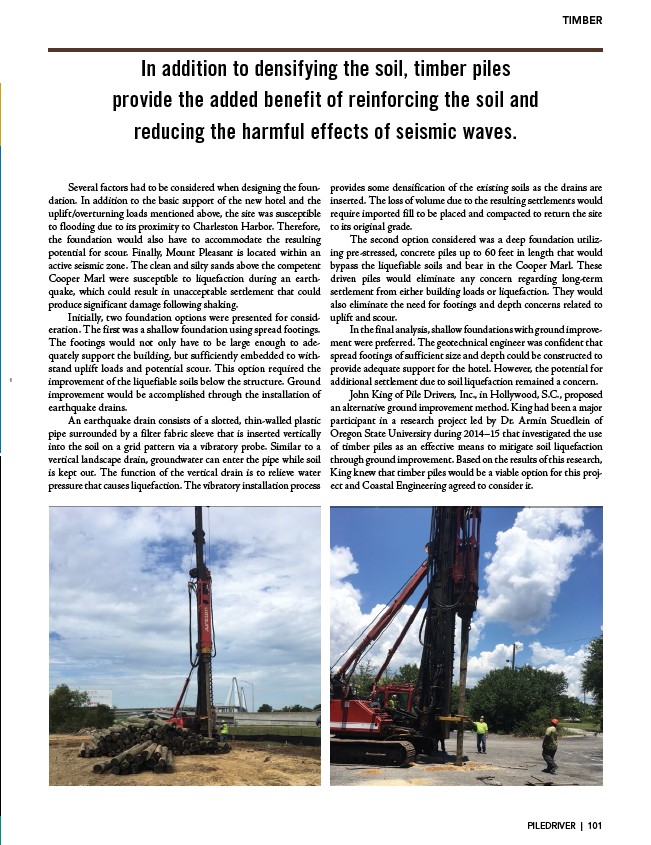
TIMBER
In addition to densifying the soil, timber piles
provide the added benefit of reinforcing the soil and
reducing the harmful effects of seismic waves.
Several factors had to be considered when designing the foundation.
In addition to the basic support of the new hotel and the
uplift/overturning loads mentioned above, the site was susceptible
to flooding due to its proximity to Charleston Harbor. Therefore,
the foundation would also have to accommodate the resulting
potential for scour. Finally, Mount Pleasant is located within an
active seismic zone. The clean and silty sands above the competent
Cooper Marl were susceptible to liquefaction during an earthquake,
which could result in unacceptable settlement that could
produce significant damage following shaking.
Initially, two foundation options were presented for consideration.
The first was a shallow foundation using spread footings.
The footings would not only have to be large enough to adequately
support the building, but sufficiently embedded to withstand
uplift loads and potential scour. This option required the
improvement of the liquefiable soils below the structure. Ground
improvement would be accomplished through the installation of
earthquake drains.
An earthquake drain consists of a slotted, thin-walled plastic
pipe surrounded by a filter fabric sleeve that is inserted vertically
into the soil on a grid pattern via a vibratory probe. Similar to a
vertical landscape drain, groundwater can enter the pipe while soil
is kept out. The function of the vertical drain is to relieve water
pressure that causes liquefaction. The vibratory installation process
provides some densification of the existing soils as the drains are
inserted. The loss of volume due to the resulting settlements would
require imported fill to be placed and compacted to return the site
to its original grade.
The second option considered was a deep foundation utilizing
pre-stressed, concrete piles up to 60 feet in length that would
bypass the liquefiable soils and bear in the Cooper Marl. These
driven piles would eliminate any concern regarding long-term
settlement from either building loads or liquefaction. They would
also eliminate the need for footings and depth concerns related to
uplift and scour.
In the final analysis, shallow foundations with ground improvement
were preferred. The geotechnical engineer was confident that
spread footings of sufficient size and depth could be constructed to
provide adequate support for the hotel. However, the potential for
additional settlement due to soil liquefaction remained a concern.
John King of Pile Drivers, Inc., in Hollywood, S.C., proposed
an alternative ground improvement method. King had been a major
participant in a research project led by Dr. Armin Stuedlein of
Oregon State University during 2014–15 that investigated the use
of timber piles as an effective means to mitigate soil liquefaction
through ground improvement. Based on the results of this research,
King knew that timber piles would be a viable option for this project
and Coastal Engineering agreed to consider it.
PILEDRIVER | 101